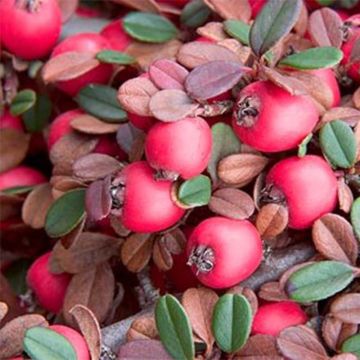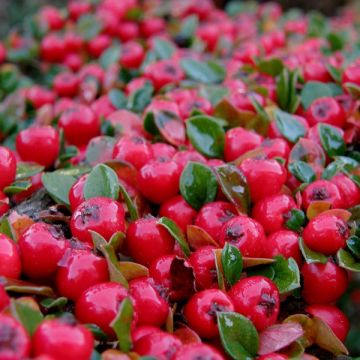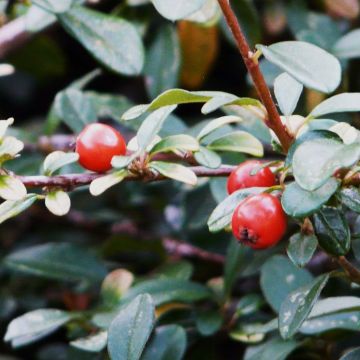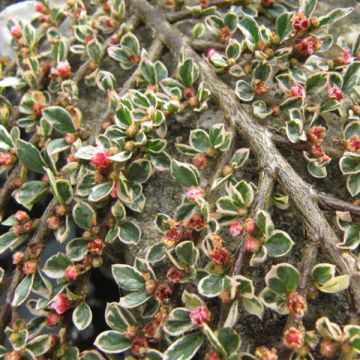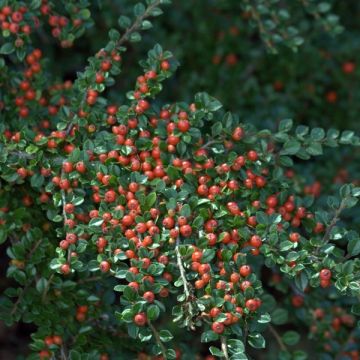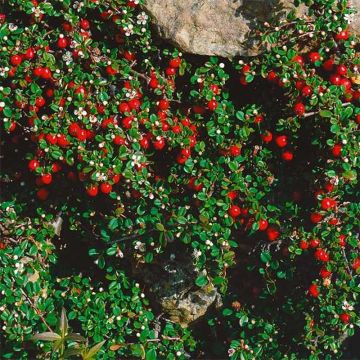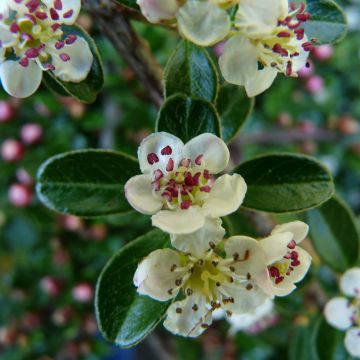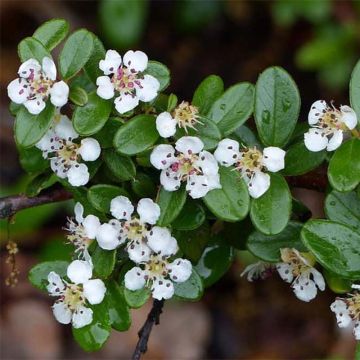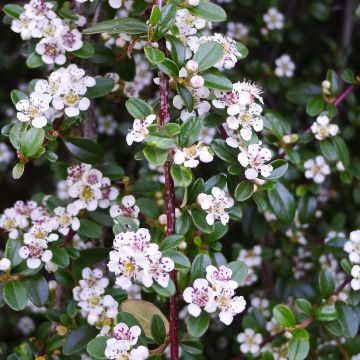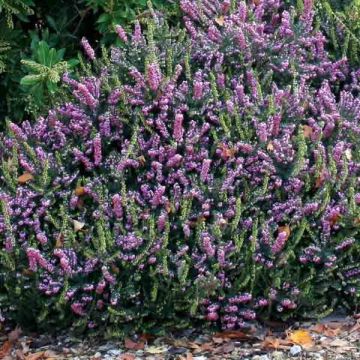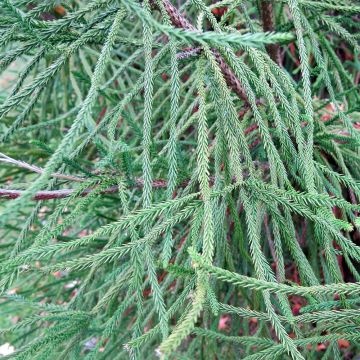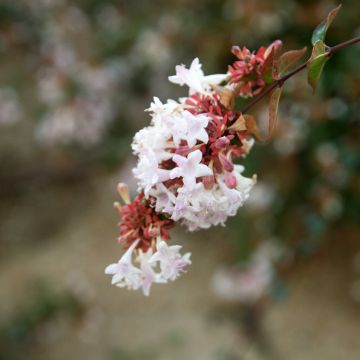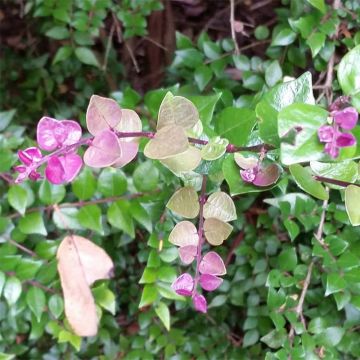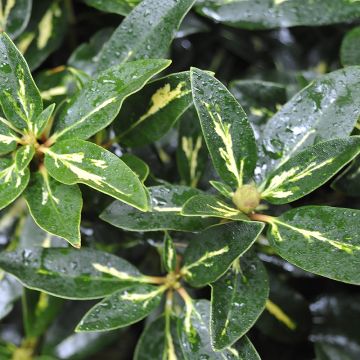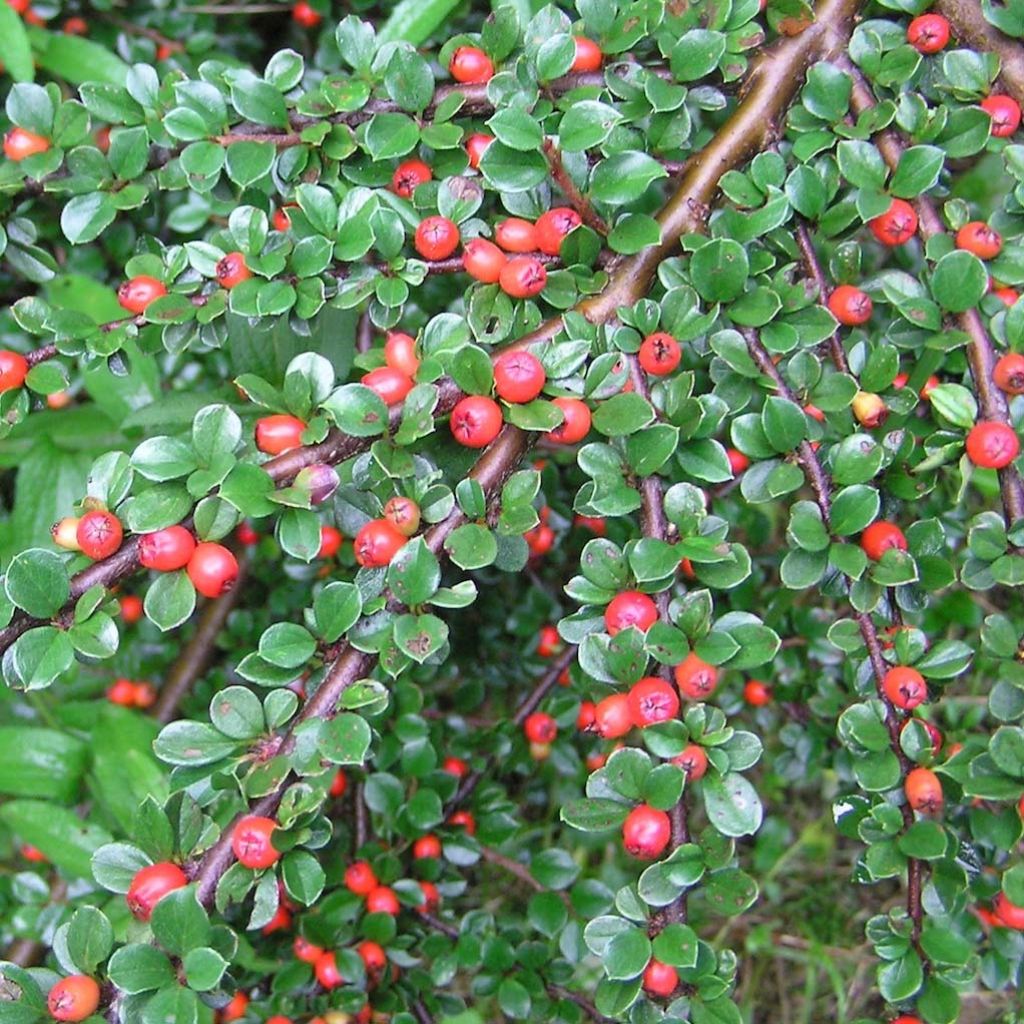

Cotoneaster dammeri Schoon
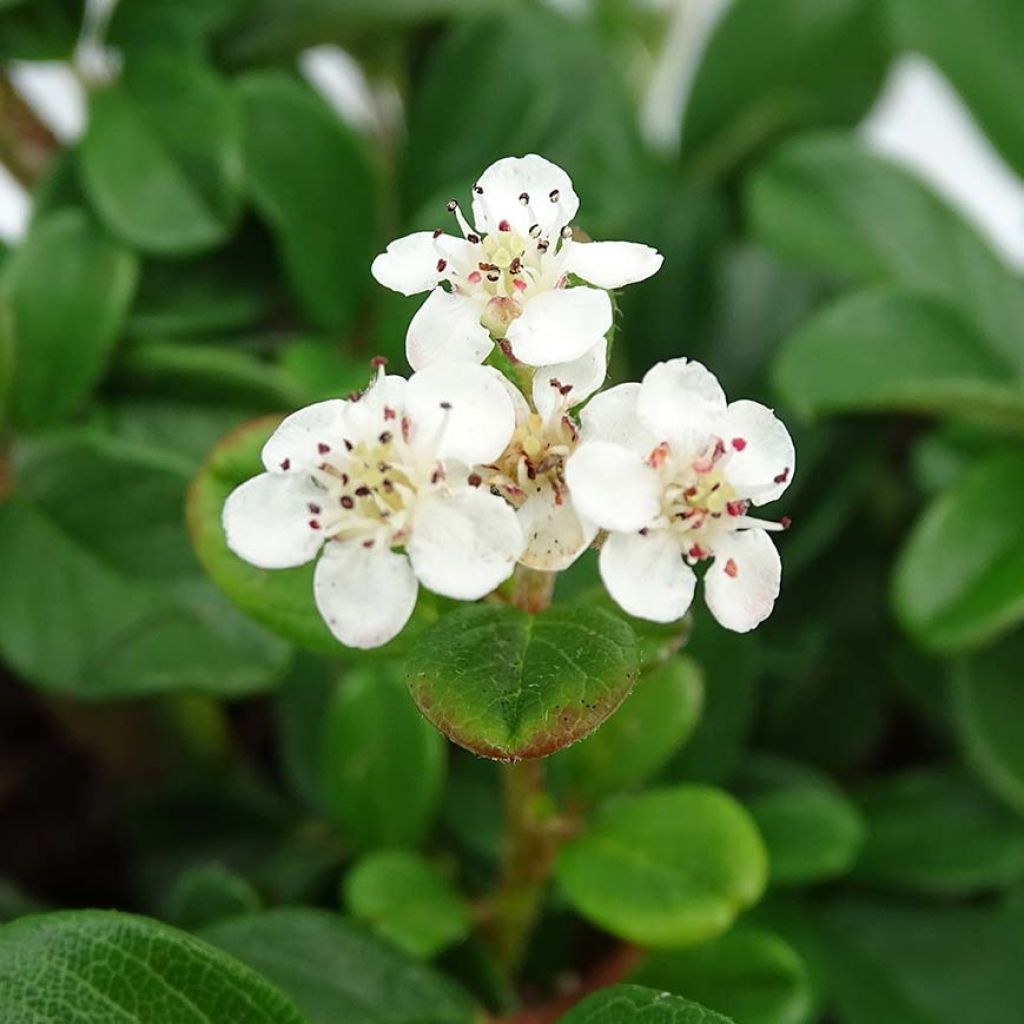

Cotoneaster dammeri Schoon
Cotoneaster dammeri Schoon
Cotoneaster dammeri Schoon
Bearberry Cotoneaster, Dammer's Cotoneaster
This item cannot be shipped to the selected country
Delivery charge from €5.90
More information
Schedule delivery date,
and select date in basket
This plant carries a 24 months recovery warranty
More information
We guarantee the quality of our plants for a full growing cycle, and will replace at our expense any plant that fails to recover under normal climatic and planting conditions.
From €5.90 for pickup delivery and €6.90 for home delivery
Express home delivery from €8.90.
Does this plant fit my garden?
Set up your Plantfit profile →
Description
Cotoneaster dammeri 'Schoon' is a cultivar valued for its abundant fruiting with small bright red balls, which are decorative from October onwards. The bush has a dense, prostrate and strongly carpeting habit and shiny dark green evergreen leaves, which are larger than those of the species. Exceptionally vigorous, it forms a ground cover 30cm (12in) in height and 2m (7ft) in width, perfectly suited for enhancing large spaces and banks. In June, it produces an abundance of small white single flowers that are highly attractive to bees. With no specific requirements, it adapts to all exposures and all soils, even dry and chalky ones.
Cotoneaster dammeri belongs to the large Rosaceae family and is native to central and western China. This vigorous shrub is able to withstand marked droughts as well as very harsh winters, even when growing in poor and rocky soil. It clearly prefers well-drained and poor soils. The cultivar 'Schoon' has a spreading habit with flexible, long and creeping reddish branches. Its growth is quite fast, reaching a height of about 30cm (12in) and a width of 2m (7ft) at maturity, and even more as its branches naturally layer. Its evergreen foliage is composed of large thick and leathery leaves. They are very dark glossy green. The flowering takes place in June, with small flowers with 5 white petals shaded with pink, quite typical of the Rosaceae family. This flowering gives way to bright red fleshy fruits measuring 5 to 7mm (0.3in) in diameter, which are greatly appreciated by birds.
Cotoneaster dammeri 'Schoon' is ideal for covering large areas in difficult parts of the garden, bringing a neat touch. In dry and hot conditions, plant it in groups with other ground cover species such as rockroses and creeping rosemary, punctuated here and there with yellow flowers of St. John's wort. While it accepts growing in almost any conditions, it will be more fruitful in full sun. Perfect at the base of a tall hedge or in a shady and bare corner of the garden, for example under a large tree, it can also be planted in a rockery to fill the spaces between other plants. Plant it on a large bank, above a wall, along a patio, or a pathway. It can be planted with creeping juniper 'Blue Star', Euonymus fortunei 'Emerald Gaiety', and Forsythia intermedia 'Marée d'Or'. Withstanding sea spray well, in coastal climates it can be accompanied by western heathers and evergreen ceanothuses.
Report an error about the product description
Cotoneaster dammeri Schoon in pictures
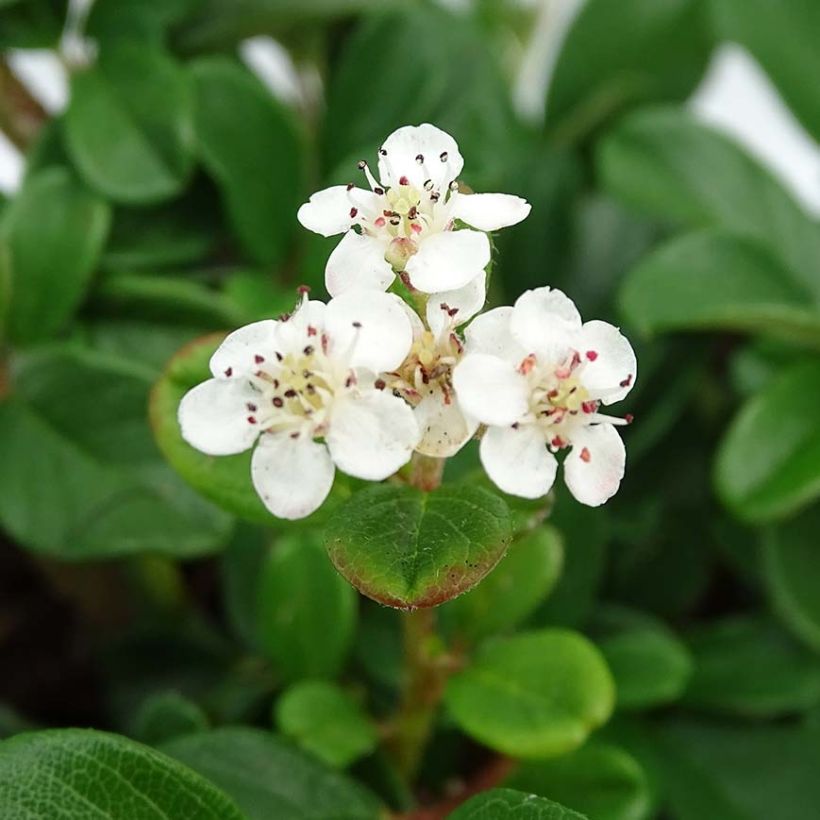

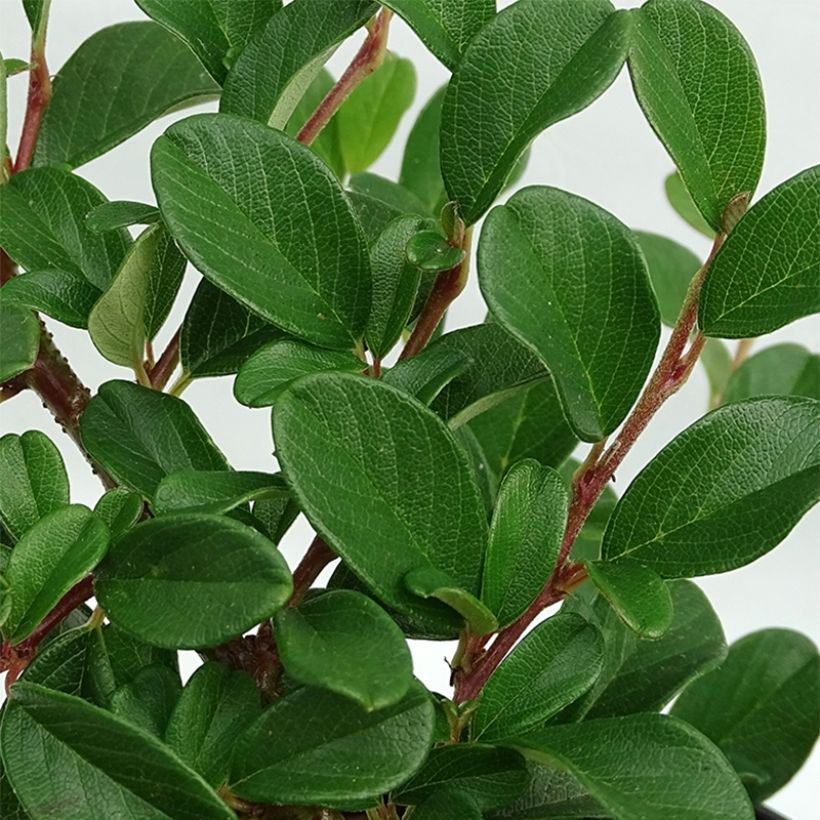

Plant habit
Flowering
Foliage
Botanical data
Cotoneaster
dammeri
Schoon
Rosaceae
Bearberry Cotoneaster, Dammer's Cotoneaster
Cultivar or hybrid
Other Cotoneaster
Planting and care
Plant Cotoneaster dammeri 'Schoon' in a sunny position where it will produce more flowers and fruit. Partial shade, or even full shade, is not a problem in hot and dry regions. It requires well-draining soil as it fears excess moisture. However, its drought tolerance is excellent once it is well-established. It will adapt to slightly acidic, neutral, or even alkaline soils, as well as rocky ones.
Planting period
Intended location
Care
This item has not been reviewed yet - be the first to leave a review about it.
Evergreen shrubs
Haven't found what you were looking for?
Hardiness is the lowest winter temperature a plant can endure without suffering serious damage or even dying. However, hardiness is affected by location (a sheltered area, such as a patio), protection (winter cover) and soil type (hardiness is improved by well-drained soil).

Photo Sharing Terms & Conditions
In order to encourage gardeners to interact and share their experiences, Promesse de fleurs offers various media enabling content to be uploaded onto its Site - in particular via the ‘Photo sharing’ module.
The User agrees to refrain from:
- Posting any content that is illegal, prejudicial, insulting, racist, inciteful to hatred, revisionist, contrary to public decency, that infringes on privacy or on the privacy rights of third parties, in particular the publicity rights of persons and goods, intellectual property rights, or the right to privacy.
- Submitting content on behalf of a third party;
- Impersonate the identity of a third party and/or publish any personal information about a third party;
In general, the User undertakes to refrain from any unethical behaviour.
All Content (in particular text, comments, files, images, photos, videos, creative works, etc.), which may be subject to property or intellectual property rights, image or other private rights, shall remain the property of the User, subject to the limited rights granted by the terms of the licence granted by Promesse de fleurs as stated below. Users are at liberty to publish or not to publish such Content on the Site, notably via the ‘Photo Sharing’ facility, and accept that this Content shall be made public and freely accessible, notably on the Internet.
Users further acknowledge, undertake to have ,and guarantee that they hold all necessary rights and permissions to publish such material on the Site, in particular with regard to the legislation in force pertaining to any privacy, property, intellectual property, image, or contractual rights, or rights of any other nature. By publishing such Content on the Site, Users acknowledge accepting full liability as publishers of the Content within the meaning of the law, and grant Promesse de fleurs, free of charge, an inclusive, worldwide licence for the said Content for the entire duration of its publication, including all reproduction, representation, up/downloading, displaying, performing, transmission, and storage rights.
Users also grant permission for their name to be linked to the Content and accept that this link may not always be made available.
By engaging in posting material, Users consent to their Content becoming automatically accessible on the Internet, in particular on other sites and/or blogs and/or web pages of the Promesse de fleurs site, including in particular social pages and the Promesse de fleurs catalogue.
Users may secure the removal of entrusted content free of charge by issuing a simple request via our contact form.
The flowering period indicated on our website applies to countries and regions located in USDA zone 8 (France, the United Kingdom, Ireland, the Netherlands, etc.)
It will vary according to where you live:
- In zones 9 to 10 (Italy, Spain, Greece, etc.), flowering will occur about 2 to 4 weeks earlier.
- In zones 6 to 7 (Germany, Poland, Slovenia, and lower mountainous regions), flowering will be delayed by 2 to 3 weeks.
- In zone 5 (Central Europe, Scandinavia), blooming will be delayed by 3 to 5 weeks.
In temperate climates, pruning of spring-flowering shrubs (forsythia, spireas, etc.) should be done just after flowering.
Pruning of summer-flowering shrubs (Indian Lilac, Perovskia, etc.) can be done in winter or spring.
In cold regions as well as with frost-sensitive plants, avoid pruning too early when severe frosts may still occur.
The planting period indicated on our website applies to countries and regions located in USDA zone 8 (France, United Kingdom, Ireland, Netherlands).
It will vary according to where you live:
- In Mediterranean zones (Marseille, Madrid, Milan, etc.), autumn and winter are the best planting periods.
- In continental zones (Strasbourg, Munich, Vienna, etc.), delay planting by 2 to 3 weeks in spring and bring it forward by 2 to 4 weeks in autumn.
- In mountainous regions (the Alps, Pyrenees, Carpathians, etc.), it is best to plant in late spring (May-June) or late summer (August-September).
The harvesting period indicated on our website applies to countries and regions in USDA zone 8 (France, England, Ireland, the Netherlands).
In colder areas (Scandinavia, Poland, Austria...) fruit and vegetable harvests are likely to be delayed by 3-4 weeks.
In warmer areas (Italy, Spain, Greece, etc.), harvesting will probably take place earlier, depending on weather conditions.
The sowing periods indicated on our website apply to countries and regions within USDA Zone 8 (France, UK, Ireland, Netherlands).
In colder areas (Scandinavia, Poland, Austria...), delay any outdoor sowing by 3-4 weeks, or sow under glass.
In warmer climes (Italy, Spain, Greece, etc.), bring outdoor sowing forward by a few weeks.

































